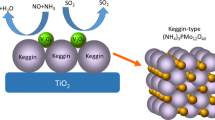Abstract
From the peculiarities of Temperature-programmed reduction (TPR) method and using the Sestak–Berggren conversion function, we describe first the TPR curve simulation procedure. The influence of the Sestak–Berggren exponents on the TPR peak maximum and shape is demonstrated, by analyzing several synthetic TPR profiles. Finally, the kinetic parameters of Au/CeO2 promoted with yttrium as well as those of Au/CeO2–Al2O3 promoted with V2O5 are discussed.





Similar content being viewed by others
References
Falconer JL, Schwarz JA. Temperature-programmed desorption and reaction: applications to supported catalysts. Catal Rev-Sci Eng. 1983;25:141–227.
Bhatia S, Beltramini J, Do DD. Temperature programmed analysis and its applications in catalytic systems. Catal Today. 1990;7:309–438.
Hurst NW, Gentry SJ, Jones A, McNicol BD. Temperature programmed reduction. Catal Rev-Sci Eng. 1982;24:233–309.
Monti DAM, Baiker A. Temperature programmed reduction. Parametric sensitivity and estimation of kinetic parameters. J Catal. 1983;83:323–35.
Munteanu G, Craiu M. Influence of the experimental parameters on the TPR profiles. React Kinet Catal Lett. 1993;50:49–54.
Friedman HL. Kinetics of thermal degradation of char-forming plastics from thermogravimetry. Application to phenolic plastic. J Polym Sci. 1964;6C:183–95.
Andreini A, Poels EK, Bliek A. Evidence for a compensation effect during the temperature programmed-reduction of copper oxide in hydrogen. React Kinet Catal Lett. 1998;63:209–17.
Munteanu G, Budrugeac P, Ilieva L, Tabakova T, Andreeva D, Segal E. Kinetics of temperature programmed reduction of Fe3O4 promoted with copper: application of iso-conversional methods. J Mater Sci. 2003;38:1995–2000.
Pratap A, Rao TLS, Lad NK, Dhurandhar HD. Isoconversional vs. Model fitting methods. J Therm Anal Calorim. 2007;89:399–405.
Burnham AK, Dinh LN. A comparison of isoconversional and model-fitting approaches to kinetic parameters estimation and application predictions. J Therm Anal Calorim. 2007;89:479–90.
Sestak J, Berggren G. Study of the kinetics of the mechanism of solid-state reactions at increasing temperatures. Thermochim Acta. 1971;3:1–12.
Sestak J. Philosophy of non-isothermal kinetics. J Therm Anal Calorim. 1979;16:503–20.
Gorbatchev M. Some aspects of Sestak’s generalized kinetic equation in thermal analysis. J Therm Anal Calorim. 1980;18:193–7.
Koga N, Matek J, Sestak J, Tanaka H. Data treatment in non-isothermal kinetics and diagnostic limits of phenomenological models. Netsu Sokutei. 1993;20:210–23.
Sestak J, Satava V, Wendlandt WW. The study of heterogeneous processes by thermal analysis. Thermochim Acta. 1973;7:333.
Munteanu G, Miclea C, Segal E. Errors in evaluation of the kinetic parameters in temperature programmed reduction. J Therm Anal Calorim. 2008;94:317–21.
Munteanu G, Ilieva L, Nedyalkova R, Andreeva D. Influence of gold on the reduction behaviour of Au–V2O5/CeO2 catalytic systems: TPR and kinetic parameters. Appl Catal A. 2004;227:31–40.
Bakhvalov N. Numerical methods. 2nd ed. Moscow: Mir; 1973.
Author information
Authors and Affiliations
Corresponding author
Rights and permissions
About this article
Cite this article
Munteanu, G., Segal, E. Sestak–Berggren function in temperature-programmed reduction. J Therm Anal Calorim 101, 89–95 (2010). https://doi.org/10.1007/s10973-009-0435-3
Received:
Accepted:
Published:
Issue Date:
DOI: https://doi.org/10.1007/s10973-009-0435-3




